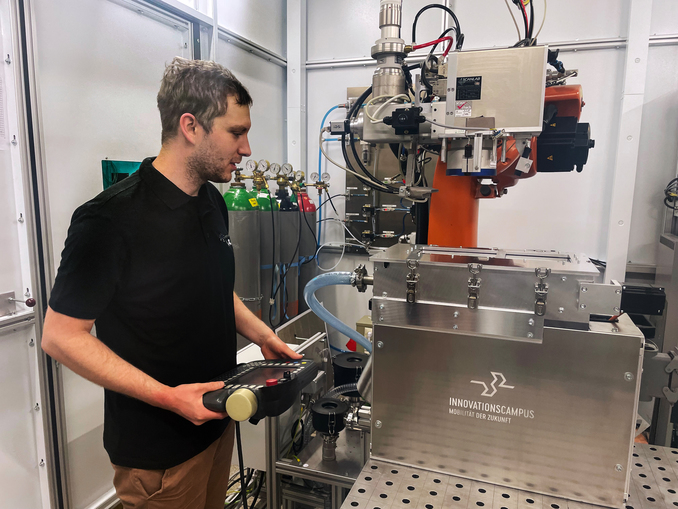Milestone on the way to increasing the efficiency of electric motors Multifunctional powder process chamber developed by LAZ at Aalen University

David Kolb, wissenschaftlicher Mitarbeiter am LAZ, hat an der Hochschule Aalen eine multifunktionale Pulver-Prozesskammer mitentwickelt. (© Hochschule Aalen | Andrea Heidel).
Laser-based additive manufacturing processes can produce components with unrivaled geometric freedom, enabling the design of novel, compact e-drives for the mobility of the future. Maximum performance with low power consumption is achieved in principle by microscopically thin air gaps in the soft magnetic components, which represent eddy current barriers and thus reduce remagnetization losses of the soft magnets. How such hollow microstructures can be optimized for maximum efficiency and manufactured directly in 3D-printed drive components is being researched as part of a project involving the LaserApplicationCenter (LAZ) at Aalen University.
Several research groups - One goal
The "ADDSUB" project under the umbrella of the "InnovationCampus Future Mobility" (ICM) will continue until the end of the year and is being funded with around 400,000 euros by the Baden-Württemberg Ministry of Science, Research and the Arts. In addition, as part of the "ADDSUB" project, the Materials Research Institute (IMFAA) at Aalen University is conducting research into characterizing the magnets that will be used in this drive of the future. Other project partners are the Institut für Strahlwerkzeuge (IFSW) from University of Stuttgart and the Institute of Production Science (wbk) from Karlsruhe Institute of Technology. The common goal of these research groups is to significantly increase the efficiency of a so-called transverse flux machine - an electric motor for wheel hub drives - through interdisciplinary, technological as well as scientific cooperation.
The project name "ADDSUB" stands for optimized production of soft magnetic components for electric machines that meet requirements by combining additive and subtractive laser processes. In simple terms, a part is built using a 3D printing process and, at the same time, microscopically small cavities are created by subtractive ablation during the build process with the laser in order to increase the subsequent performance of the motor. All this happens in a single machine. The LaserApplicationCenter has now reached an important milestone within the project by succeeding in developing and building a multifunctional powder process chamber at Aalen University.
Modular, transportable and highly dense chamber developed
To avoid negative oxide influences, this compact powder process chamber has a high-density build space, that can be filled with inert gas, with associated inert gas circulation and gas purification. David Kolb, a research associate at LAZ, lists the other advantages of the design: "It is a fully comprehensive powder bed for additive manufacturing of a wide range of industrial and commercial materials. But we can also process new materials in it." In addition, he said, the process chamber is suitable not only for additive manufacturing, but also for combining additive and subtractive manufacturing.
The concept is also designed to be modular and transportable, he said, and can be used on different laser systems. "The laser setup can be individually adapted to the material to be processed," he further explains. The setup is fully automated, compact, flexible and easily adaptable, he adds, and also features a range of sensors. The ultimate goal of the project is to use the results of the research to increase the efficiency of electric motors and thus at the same time make an important contribution to maintaining the competitiveness of manufacturers and suppliers in Baden-Württemberg.
